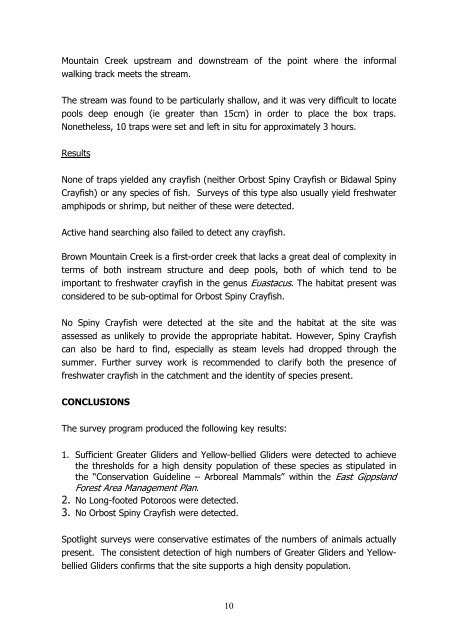Surveys for arboreal mammals, Long-Footed Potoroo and Spiny ...
Surveys for arboreal mammals, Long-Footed Potoroo and Spiny ...
Surveys for arboreal mammals, Long-Footed Potoroo and Spiny ...
Create successful ePaper yourself
Turn your PDF publications into a flip-book with our unique Google optimized e-Paper software.
Mountain Creek upstream <strong>and</strong> downstream of the point where the in<strong>for</strong>mal<br />
walking track meets the stream.<br />
The stream was found to be particularly shallow, <strong>and</strong> it was very difficult to locate<br />
pools deep enough (ie greater than 15cm) in order to place the box traps.<br />
Nonetheless, 10 traps were set <strong>and</strong> left in situ <strong>for</strong> approximately 3 hours.<br />
Results<br />
None of traps yielded any crayfish (neither Orbost <strong>Spiny</strong> Crayfish or Bidawal <strong>Spiny</strong><br />
Crayfish) or any species of fish. <strong>Surveys</strong> of this type also usually yield freshwater<br />
amphipods or shrimp, but neither of these were detected.<br />
Active h<strong>and</strong> searching also failed to detect any crayfish.<br />
Brown Mountain Creek is a first-order creek that lacks a great deal of complexity in<br />
terms of both instream structure <strong>and</strong> deep pools, both of which tend to be<br />
important to freshwater crayfish in the genus Euastacus. The habitat present was<br />
considered to be sub-optimal <strong>for</strong> Orbost <strong>Spiny</strong> Crayfish.<br />
No <strong>Spiny</strong> Crayfish were detected at the site <strong>and</strong> the habitat at the site was<br />
assessed as unlikely to provide the appropriate habitat. However, <strong>Spiny</strong> Crayfish<br />
can also be hard to find, especially as steam levels had dropped through the<br />
summer. Further survey work is recommended to clarify both the presence of<br />
freshwater crayfish in the catchment <strong>and</strong> the identity of species present.<br />
CONCLUSIONS<br />
The survey program produced the following key results:<br />
1. Sufficient Greater Gliders <strong>and</strong> Yellow-bellied Gliders were detected to achieve<br />
the thresholds <strong>for</strong> a high density population of these species as stipulated in<br />
the “Conservation Guideline – Arboreal Mammals” within the East Gippsl<strong>and</strong><br />
Forest Area Management Plan.<br />
2. No <strong>Long</strong>-footed <strong>Potoroo</strong>s were detected.<br />
3. No Orbost <strong>Spiny</strong> Crayfish were detected.<br />
Spotlight surveys were conservative estimates of the numbers of animals actually<br />
present. The consistent detection of high numbers of Greater Gliders <strong>and</strong> Yellowbellied<br />
Gliders confirms that the site supports a high density population.<br />
10





![Metcalfe State Forest Fauna Species List [PDF File - 16.9 KB]](https://img.yumpu.com/22024301/1/184x260/metcalfe-state-forest-fauna-species-list-pdf-file-169-kb.jpg?quality=85)






![PPE Price List for Wildlife Volunteers [PDF File - 20.3 KB]](https://img.yumpu.com/15321634/1/190x135/ppe-price-list-for-wildlife-volunteers-pdf-file-203-kb.jpg?quality=85)




